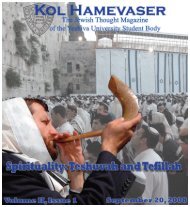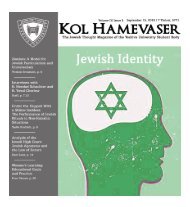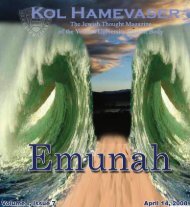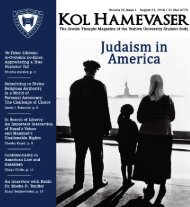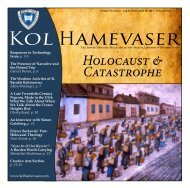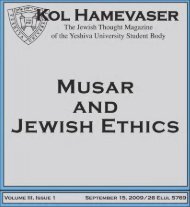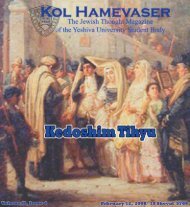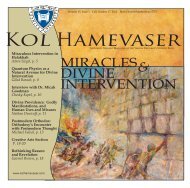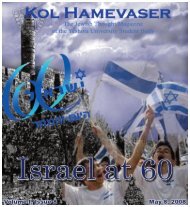Create successful ePaper yourself
Turn your PDF publications into a flip-book with our unique Google optimized e-Paper software.
Netsiv. His Yoreh De’ah, where pots <strong>and</strong> pans<br />
became theoretical halakhic constructions, was<br />
the same Yoreh De’ah that the Shakh had commented<br />
upon. As is exemplified by kiddush hahodesh<br />
(the sanctification of the new month),<br />
the choice of which day rosh hodesh (first day<br />
of the new Jewish month) will fall out on is in<br />
the h<strong>and</strong>s of the Sanhedrin, even if they intentionally<br />
avoid selecting the most natural day.<br />
However, their choice is still limited; they may<br />
choose to make the previous month 29 or 30<br />
days, but no less <strong>and</strong> no more.<br />
Examples such as the aforementioned decision<br />
of the Hafets Hayyim to permit the Bais<br />
Yaakov movement, or, similarly, the Rav’s encouragement<br />
of women to engage in talmud<br />
Torah at higher levels, can be viewed in one of<br />
two ways. Some suggest that they fall under<br />
the category of “Et la’asot la-Hashem, heferu<br />
Toratekha” – “It is a time to act for Hashem;<br />
they have annulled your Torah” (Tehillim<br />
119:126). This concept was used to permit the<br />
writing of the Torah she-be-Al Peh (Oral Law)<br />
(Gittin 60a), <strong>and</strong> is used in similar, very limited<br />
cases where the violation of certain principles<br />
is necessary for the protection of the Jewish<br />
people (see Rashi to Tehillim ibid., s.v. “Et”).<br />
Rambam compares this to the necessary evil of<br />
undergoing an amputation to save the rest of<br />
the body – if Torah was not written down, it<br />
would have been lost forever. The state of affairs<br />
in Europe following the Enlightenment<br />
<strong>and</strong> later in America, where many women were<br />
pursuing higher degrees, prompted this principle<br />
to be invoked. Others claim that these<br />
breaks from tradition are in fact an ideal, for<br />
women are allowed or even should be encouraged<br />
to increase their underst<strong>and</strong>ing of Torah.<br />
They will have a kiyyum (fulfillment) of talmud<br />
Torah, <strong>and</strong> at the very least their Torah<br />
knowledge should be on equal footing with<br />
their secular studies.<br />
xxxiv Ketsot ha-Hoshen, Introduction, s.v. “Uba-Zeh<br />
yuvan,” <strong>and</strong> “U-be-Midrash;” qtd. in<br />
Ginat Egoz, p. 7.<br />
<strong>Halakhah</strong> <strong>and</strong> <strong>Minhag</strong><br />
An Interview with Rabbi Hershel Schachter<br />
BY: Staff<br />
Who is qualified to give a pesak <strong>Halakhah</strong><br />
(halakhic ruling)? What<br />
makes his ruling binding upon a<br />
large group of people?<br />
To give an original pesak on a new<br />
she’eilah (halachic question) or a hachra’ah<br />
(decision) on an old machalokes is not easy. A<br />
person has to have a strong tradition in Torah<br />
logic. Common sense has its own system of<br />
logic <strong>and</strong> so does Halachah. And to know Talmudic,<br />
halachic logic, you have to be learned<br />
in all areas of Torah. A posek cannot “specialize”<br />
in one area of Halachah alone. In order to<br />
be an expert in medical Halachah, you have to<br />
know Nashim, Nezikin, Kodashim, <strong>and</strong> Tohoros,<br />
because everything in Halachah is interconnected<br />
<strong>and</strong> interrelated.<br />
Most rabbanim who have semichah are<br />
not qualified to issue an original pesak – not<br />
just on a new she’eilah that comes up, but even<br />
an old one where there are different opinions.<br />
If a person does not have the tradition of how<br />
to navigate <strong>and</strong> decide, he is simply not eligible<br />
to do so. The Gemara in Avodah Zarah (5a)<br />
says that you have to be 40 years old to paskn<br />
a halachic question, unless there is no other<br />
talmid chacham over the age of forty who is<br />
available. i I once taught this in public, <strong>and</strong> Dr.<br />
Lamm got very upset with me, saying that we<br />
are not going to withhold every musmach’s<br />
semichah until he is forty. I responded, though,<br />
that if a musmach is going to lead a community<br />
where there is no one else over the age of forty<br />
who is qualified to paskn, you have no<br />
bereirah (choice) <strong>and</strong> should grant him semichah.<br />
Otherwise, if he is going to live in New<br />
York, there are plenty of other talmidei<br />
chachamim over 40 available by telephone. In<br />
such a case, it is inappropriate for such a young<br />
musmach to paskn.<br />
Sometimes, of course, it is an open-<strong>and</strong>shut<br />
she’eilah. In such a situation of mar’eh<br />
makom ani lach (I am simply pointing you to<br />
a source), it would be appropriate for a person<br />
under 40 to paskn. ii However, in a lot of instances,<br />
it might, when looked at from a circumscribed,<br />
focused perspective, seem to be<br />
the exact same she’eilah, but because of some<br />
outside factors it in fact is not <strong>and</strong> you have to<br />
apply a different se’if (paragraph) when<br />
paskening. Oftentimes, because the world is<br />
changing so quickly, a question that once received<br />
one answer will today require a different<br />
one.<br />
In terms of authority in pesak, the Chummash<br />
tells us that the pesakim of the Beis Din<br />
ha-Gadol (Great Court) are binding on everybody.<br />
iii I think the reason that they are binding<br />
is that the Beis Din ha-Gadol is not a political<br />
body, but is rather composed of the gedolei hador<br />
(greatest men of the generation). As a result,<br />
its members have the status of rav muvhak<br />
(primary teacher) for the entirety of Kelal Yisrael,<br />
even if they have never met their<br />
talmidim, <strong>and</strong> the din is that the pesak of a rav<br />
muvhak is binding on his students. iv Similarly,<br />
the mara de-asra (local rabbinic authority) of<br />
a particular area is considered the rav muvhak<br />
of all of his balabatim, which gives his pesak<br />
a level of authority over them. If a person davens<br />
in a few shuls, he should listen to the pesakim<br />
of the person he considers his rav<br />
muvhak, who made him into a talmid chacham<br />
<strong>and</strong> a Torah personality.<br />
Which characteristics should a person<br />
look for when choosing a personal/family<br />
posek? Is it appropriate to choose one posek<br />
for one area of <strong>Halakhah</strong> <strong>and</strong> another for a different<br />
area? Is it problematic, halakhically or<br />
otherwise, for someone to ask she’eilot to a<br />
rabbi other than the leader of his or her<br />
shul/kehillah?<br />
The Mishnah says “aseh lecha rav” v –<br />
you have to pick a rav to paskn all of your<br />
she’eilos. He has to first <strong>and</strong> foremost be very<br />
knowledgeable. If I know that my rabbi is not<br />
so learned, even if he is a very nice person, I<br />
simply cannot rely on him to paskn.<br />
Second, he has to be humble. The Gemara<br />
says that we paskn like the Beis Hillel against<br />
the Beis Shammai, because, among other reasons,<br />
the Beis Hillel were more humble than<br />
the Beis Shammai, <strong>and</strong> one who is more humble<br />
st<strong>and</strong>s a better chance of succeeding in<br />
pesak. vi If one lacks humility, he will make up<br />
his mind in advance that he is going to stick to<br />
his opinion <strong>and</strong> will not be willing to listen to<br />
the facts or be open to changing his view. Conversely,<br />
a person who is humble is not going<br />
to insist that his muskal rishon (first impression)<br />
is correct, but will rather consider every-<br />
Volume III, Issue 7 www.kolhamevaser.com<br />
thing before him.<br />
He also has to be an honest person. Sometimes<br />
you have a rabbi who is a politician <strong>and</strong><br />
says one thing to one person <strong>and</strong> another thing<br />
to a different person, giving everyone the answer<br />
that he wants to hear. That is obviously<br />
inappropriate.<br />
Finally, he must be a yere Shamayim<br />
(God-fearer). The Gemara talks about why the<br />
pesakim of talmidei chachamim are binding<br />
<strong>and</strong> says that it is because “sod Hashem liyere’av”<br />
vii – God gives the secrets of underst<strong>and</strong>ing<br />
the Torah to those who fear Him. viii<br />
Usually, we assume that the more learned one<br />
is, the more yir’as Shamayim he has. If, however,<br />
the rabbi of my choice is very learned but<br />
seems, unfortunately, to lack yir’as Shamayim,<br />
he is not ra’ui (worthy) to receive divine assistance<br />
in figuring out what the dinim are.<br />
In picking a rabbi, then, you have to make<br />
sure he is very learned, humble, honest, <strong>and</strong><br />
God-fearing, <strong>and</strong> then we assume that God will<br />
assist him <strong>and</strong> prevent him from making a mistake<br />
in pesak.<br />
In terms of seeking out multiple posekim,<br />
the Chazon Ish writes that years ago there was<br />
one rabbi in each community who was an expert<br />
on everything; he was able to paskn, give<br />
a pilpul shi’ur, <strong>and</strong> decipher difficult statements<br />
of the Rambam. The Noda bi-Yehudah<br />
[Rav Yechezkel L<strong>and</strong>au] is a good example of<br />
this model: he gave shi’urim to his talmidim,<br />
wrote teshuvos <strong>and</strong> paskened she’eilos, <strong>and</strong> delivered<br />
derashos (sermons) to balabatim.<br />
Then, after the Industrial Revolution, when<br />
everything began to run according to a division<br />
of labor – this person made the right sleeves on<br />
the suit, the other one the left sleeves, <strong>and</strong> a<br />
third one the pockets – the same thing happened<br />
in the world of learning: one person became<br />
an expert in one area of Halachah <strong>and</strong><br />
another an expert in a different area. We, too,<br />
have developed a division of labor. In fact, Rav<br />
Chayyim Ozer Grodzenski, when Rabbi Elie<br />
Munk asked him about the eruv in Paris, sent<br />
the she’eilah to the Chazon Ish in Bnei Brak,<br />
because he considered him an expert in eruvin.<br />
Similarly, when he had a question in Hilchos<br />
Mikva’os, he sent it to the Chazon Ish’s<br />
brother, who was considered an expert in that<br />
area. In every yeshivah today, you encounter<br />
the same thing: you have the Rosh Yeshivah<br />
who says the pilpul shi’ur <strong>and</strong> explains difficult<br />
statements of the Rambam, the posek who<br />
paskens the she’eilos, <strong>and</strong> the mashgiach who<br />
gives shi’urim on Hashkafah <strong>and</strong> emunah<br />
(faith).<br />
This trend, however, is somewhat problematic,<br />
because each person has a different<br />
style <strong>and</strong> mahalach (method) in his<br />
machashavah <strong>and</strong> mode of pesak. No two people<br />
are exactly the same. Rav Chayyim<br />
Soloveitchik’s <strong>and</strong> Rav Velvele’s sefarim share<br />
much in common but are, in fact, very different<br />
21



